One parting post on last weeks commercial fire in Evanston, some interesting apparatus shots from Steve Redick.
- Perhaps someone can comment on this, but the webmaster can’t remember another time (certainly in recent years) that all five Evanston engines were pumping at the same fire
- Steve has the first shot we’ve seen of the Glenview/Northfield Truck 14/29 in service and labeled as Truck 29
- Wilmette and Winnetka engines were also pumping at the scene, though Steve tells us that they were each substituted for Evanston engines that required fuel
- an interesting note, with the inclusion of the Wilmette and Winnetka engines, this fire utilized Engines 21, 22, 23, 24 25, 26, & 28 … almost a complete sequence of numerical units …
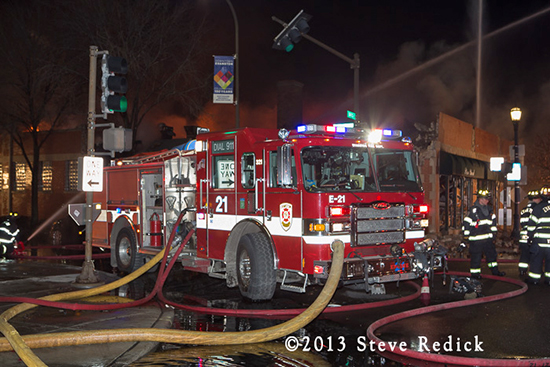
Evanston Engine 21. Steve Redick photo
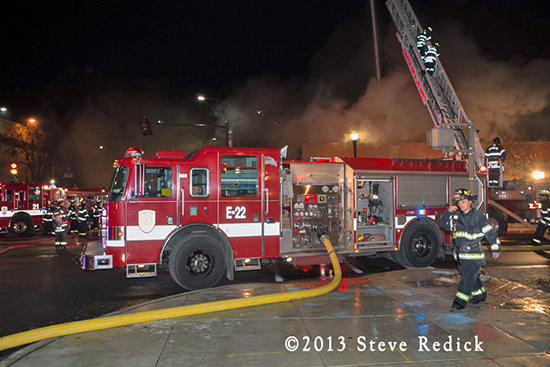
Evanston Engine 22. Steve Redick photo
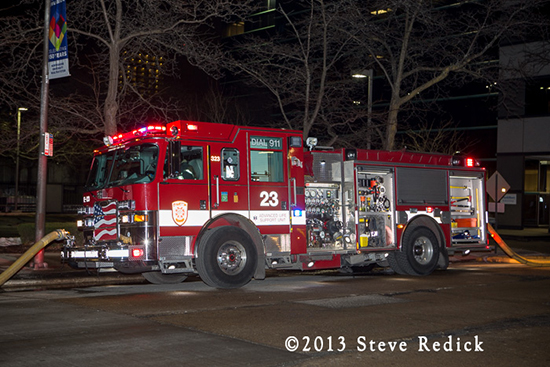
Evanston Engine 23. Steve Redick photo

Evanston Engine 24. Steve Redick photo
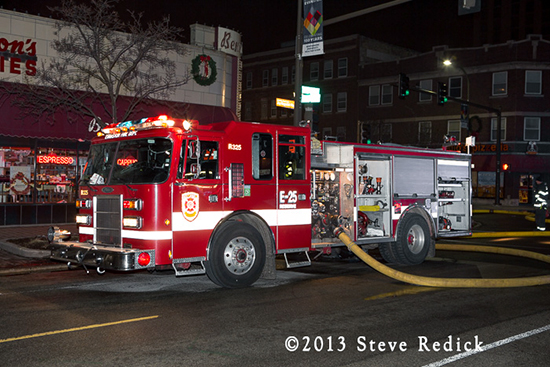
Evanston Engine 25. Steve Redick photo
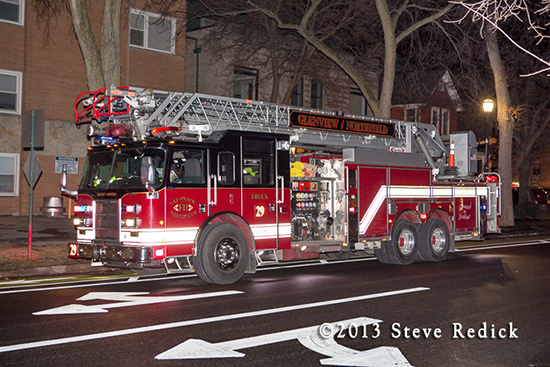
Northfield Truck 29. Steve Redick photo

Wilmette Engine 26. Steve Redick photo
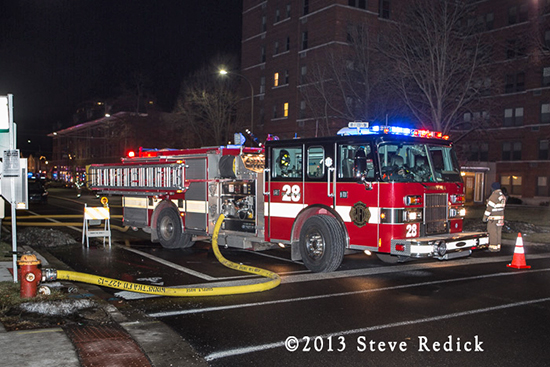
Winnetka Engine 28. Steve Redick photo






























#1 by Phil Stenholm on January 9, 2014 - 5:58 PM
BILL: The Evanston Fire Department went (occasionally) to three-man companies gradually over a period of years, starting with Engine Co. 3 & Engine Co. 4 (only) in 1942 when the first Kelly Days were instituted in lieu of giving firefighters a pay raise.
At the time, both Engine Co. 3 & Engine Co. 4 were ten-man companies (just as they were in 1928), with five men on each platoon (shift). Up until that time, firefighters had been working an 84-hour work-week, and both Engine Co. 3 and Engine Co.; 4 could run one-man short (so that the company would operate as a four-man crew instead of five).
But starting in 1942 Evanston firefighters began to receive an extra day off (a “Kelly Day”) every 15 days to reduce their average work-week from 84 hours to 73-1/2 hours. Because of that, there were certain days when Engine Co. 3 and/or Engine Co. 4 were pre-scheduled to run as a four-man company and other days when the company would be pre-planned to operate as a five-man company. If a member called in sick or was on vacation on a day when another member of the platoon was on a Kelly Day, then the company would operate with only three men.
I think it’s what the Chicago Fire Department now calls a “variance.”
Anyway, additional Kelly Days were added in 1948, with firefighters getting an extra day-off every ten days and reducing the average work-week to 67-1/2 hours. At this point Engine Co. 2 (in adition to Engine Co. 3 and Engine Co. 4) began to have a potential three-man “variance” on certain days.
When Truck Co. 23 was placed into service in 1955, all eight companies (five engines and three trucks) could run as three-man companies if necessary, although they could just as easily operate with four men if no members were absent due to illness or vacation.
When the three-platoon system (56-hour work-week) was implemented on April 1, 1957, Kelly Days were eliminated, but staffing on the EFD’s engine and truck complanies did not increase. For example, Engine Co. 23 ran as a ten-man company prior to the the three-platoon system being implemented and after the three-platoon system was implemeted, but instead of having five men on each platoon as it had on the two-platoon schedule, there were now just three men on each platoon plus a 10th man who would cover the absence of a company member (on any one of the company’s three platoons) absent due to vacation or illness. Occasionally the 10th man would not be needed to cover an absence and he would work his “regular” shift, and when that happened the company would actually run as a four-man company, although it wasn’t typical.
When Truck Co. 23 was taken out of service on December 31, 1962, the company’s manpower was transferred to Squad 21 as the Squad became a full-service squad-engine company (it had been just a two-man rescue squad before that). This allowed the two men formally assigned to Squad 21 and the Shift Commander’s buggy driver to be assigned as a full-time fourth man on Squad 21, Truck 21. and Truck 22, so that only the five engine companies now ran as three-man companies.
However, the implementation of Fire Department paramedics and ambulances and EMS in 1976-77 resulted in the extra men from the two trucks and Squad 21 to be assigned to Ambulance 1 (which ran as a three-man unit the first year it was in service in 1976), and then the third person from Ambulance 1 and the third person from Squad 21 were transferred to Ambulance 2 when a second ambulance was placed into service in 1977 as now both ambulances operated with two-person crews.
Although it was nio longer a “company,” Squad 21 still had two people assigned to it each shift, and the Squad 21 team was used to staff Ambulance 3 when it was needed. However, A3 at that time was a BLS ex-Skokie F. D. Cadillac ambulance that was only dispatched in a pinch when A1 and A2 were unavailable, and apparently nobody could foresee a time when the third ambulance would be an ALS unit and there would be enough paramedics in the EFD to staff it 24/7.
So the manpower assigned to Squad 21 was dropped in 1980 to provide coverage for more Kelly Days (what were by that time called “Short Days”) for Evanston firefighters, and minimum staffing was dropped from 28 to 26, and it’s been 26 ever since. Too bad, too, because there actually would have eventually been a good use for the 27th and 28th people on each shift, as the crew to staff Ambulance 3 (Ambulance 23) full time.
As for when the EFD started dispatching a third engine to fires, I was dispatching there at the time, and I think it was in 1985 or ’86. It had to with the use of Ambulance crews at fires.
Prior to the policy where a third engine was dispatched to reports of a structure fire, the two paramedics assigned to the ambulance on the call would function as regular firefighters on the fireground, sometimes advancing hose lines or cutting a hole in the roof. A couple of times the paramedics were needed to tend to an injured firefighter (this was before the days of a dedicated RIT unit) and they were occupied doing something related to fire suppression and so a second ambulance had to be dispatched, leaving the city with no ambuances since Ambulance 3 could only be staffed in both truck companies were in service.
So the powers that be decided to have the ambulance crew initially assigned to incident remain with their MICU and stand by in case of an injury to a firefighter, and instead a third engine company would be dispatched to provide the manpower formally provided by the ambulance crew (or by Squad 21 prior to 1977).
#2 by Bill Post on January 9, 2014 - 12:07 PM
That was a very fine piece Phil. I remember when the new fire station 1 at 1332 Emerson was opened it was somewhat of a let down for me as the old Station 1 (Headquarters) was such a large and impressive station in such a huge multi purpose building. Station 1 on Lake street was within 2 blocks of downtown Evanston and I remember that it even had a servicing bay. It is true that Station 1 and 2 weren’t more then a mile apart and that for many years both of Evanstons in service Trucks were at those 2 stations and that is why one of the smartest moves in my opinion is when they finally relocated Truck 21 to Station 3 on Central street in order to better cover the town.
Phil was there a specific year that Evanston went from 4 man Engines and Trucks to 3 man companies or was it done gradually over several years. I would guess sometime in the late 1960’s or 70’s?
That is an obvious mistake that most the suburban fire departments had made which they are all living with to this day however there is no way (in this day and age) that the 4th man will be restored to the suburban Engines and Trucks and that is probably why Evanston began the practice of dispatching a third Engine on what appears to be a working fire. That was probably also done to make up for Evanston Squad 21 being taken out of service as a fully manned company as well.
Presently the most realistic thing that Evanston can hope for is making Ambulance 23 into a fully manned company without having to take Engine 23 out of service in order for it to go out on a run. That is difficult enough as just a few years ago the VIllage Manager attempted to take one of the Trucks permanently out of service to man the third ambulance. I’m glad that the arbitrator ruled in favor of the Evanston fire fighters.
#3 by Phil Stenholm on January 8, 2014 - 5:04 PM
Although it wasn’t formally established until almost 15 years later, the origin of MABAS Division 3 can perhaps be traced to a day in July 1953, when a number of North Shore fire departments (Evanston, Wilmette, Winnetka, Glencoe, Northbrook, Highland Park, and the Glenview Naval Air Station) participated in a joint training exercise held under the auspices of the Northeastern Illinois Fire Chiefs Association at New Trier High School in Winnetka. This was the first-ever such gathering of many of the departments that would eventually form MABAS Division 3.
The need for combined training was noted by the local chiefs after several fire departments responded into the Village of Wilmette on November 28, 1952, assisting the Wilmette F. D. battling a large fire at St. Augustine’s Episcopal Church at 1122 Oak Ave.
#4 by Scott on January 3, 2014 - 11:09 PM
For all regarding MABAS card responses: The Box card, from the Box level and up is still set by each individual town. It has nothing to do with MABAS (other than having to follow a standard template for the blank cards) or any dispatch center. So, as all know, politics and other factors account for who is due!
#5 by Jim on January 3, 2014 - 7:17 PM
I agree with you Bill. That would provide the quickest service. Closest unit is the way to go. It shouldn’t matter if you are in a different division. Maybe Illinois MABAS can consolidate into one
The problem you run into is dispatch is not the same. Although with all of these consolidations among dispatch services, that may change soon.
#6 by Karl on January 3, 2014 - 3:26 PM
Bill,
Yes, Tower Ladder 26 is the E-ONE and 27 is the used Pierce from Hammond. Those rigs are assigned to those stations. So when you hear tower 27 running, it’s the Pierce running. Then station 26 will be running the older E-ONE engine. So basically E27 and TL26 are the frontline rigs. Then those are rotated every 6 months.
The photo of E26 at the evanston fire was running as E27 but in E26’s rig.
Hope this helps.
#7 by Bill Post on January 3, 2014 - 10:33 AM
Thanks for the information Karl. So that probably means that Station 27 is running as Tower Ladder 27 and Station 26 is running as Engine 26 presently ,correct?
It’s too bad that the MABAS system in Division 3 doesn’t alway’s dispatch according to the fire companies distance from the fire (like Chicago and most cities do) instead of just sending one about one company a piece from other suburbs in the Division, because Wilmette’s Tower Ladder is actually closer to that part of Evanston then Skokie’s Tower Ladder 16 is.
One of the things is that there is only one MABAS box number for a standard structure fire for all of Evanston so no matter where the fire is in Evanston the same equipment will be dispatched in the extra Alarms after a MABAS box is requested.
Some of the towns in Division 3 such as Glenview ,Niles and Northbrook have their areas divided up into different MABAS box districts while other towns like Evanston ,Skokie and LIncolnwood only have one MABAS box number response (for a structure fire) village wide.
Evanston and Lincolnwood do have a separate High Rise Box response however.
#8 by Karl on January 3, 2014 - 1:05 AM
Wilmette does the engine/tower ladder rotation about every six months. They do not jump between engine/tower in each house on a regular basis. Part of the reasoning behind this is to run all the apparatus equally throughout the year.
#9 by Bill Post on January 2, 2014 - 10:05 PM
In regards to Wilmette Engine 26 I understand that over the last year they had moved the reserve Tower Ladder from Station 26 to Station 27 and they also mover the reserve Engine from station 27 to Station 26 so that both stations each have and Engine , a Tower Ladder and of course an Ambulance stationed there. The real shocker that I had read however is that supposedly they switch off as the which station runs with the Engine company in service and which station is running with the Truck company in service that day. So my question is how often do they switch assignments between the Engines and Trucks running from both stations? Are the assignments changed every week ,every month or just at random? Apparently if Engine 26 responded to the extra alarm in Evanston then was the crew at Station 27 running as a Truck company that day or is Engine 26 a “jump company” ?
#10 by SB on January 2, 2014 - 7:57 PM
Wilmette’s New eMAX is marked for Engine 27, so my guess is station 27
#11 by Michael M on January 2, 2014 - 7:18 PM
Which station will Wilmette’s new EMax be at?
#12 by Michael M on January 2, 2014 - 7:15 PM
great shots of the engines, also love the extra info.
#13 by Tom Foley on January 2, 2014 - 6:12 PM
Love the added info in the post about almost a complete sequence of units. Also interesting about all Evanston units pumping.
#14 by Law Abiding Citizen on January 2, 2014 - 5:27 PM
Wilmette does have a new EMax, not in service yet. Evanston E 25 was the reserve pumping that fire.
#15 by Law Abiding Citizen on January 2, 2014 - 5:26 PM
Glenview and Northfield entered a truck sharing agreement last year. The truck you saw in Steve’s shot as T29 runs as Northfields truck unless Glenview’s T14 goes down, then they physically take the Northfield truck to run as their reserve.
Clear as mud?…
#16 by Chris S. on January 2, 2014 - 3:58 PM
I obviously missed something, can you explain the Glenview/Northfield Truck or point me towards a post about it, thanks
#17 by Admin on January 2, 2014 - 4:03 PM
you can go to the search field and search Glenview or Northfield and you’ll find the explanation
#18 by Michael M on January 2, 2014 - 3:34 PM
How old is the Engine 25 in this photo? It is not the 2013 Arrow XT. I am guessing they were using their reserve.
Also doesn’t Willmette have a new E-One EMax pumper?